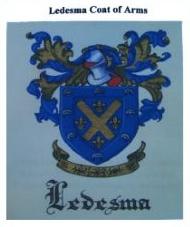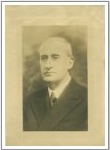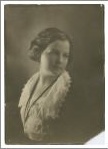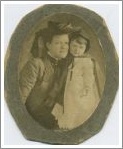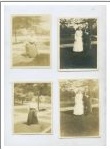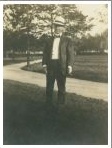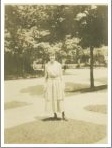"It's fascinating because every once in a while you find a piece on one of these people that illuminates a whole period of history in a way that causes you to see that time in a new way." --- John L. Robinson
Here are some interesting history items that we turned up in our genealogical research. We are direct descendants of each person. Most of what follows is quoted from correspondence with my brother John Robinson in the last decade. == Click on the thumbnails to enlarge.
John Robinson [our great-grandfather 1819-1863]
- Grandson of Valentine Best. The scuttlebutt is that John
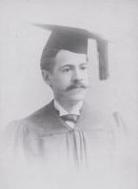 Robinson was admitted into Yale because he demonstrated that he could recite Demosthanes
in Greek from memory without putting rocks in his mouth (as the original
Demosthanes, a stutterer, had to do). He gave the commencement address at Yale in 1848 entitled
"Arthur O'Connor, Irish Revolutionary."
Robinson was admitted into Yale because he demonstrated that he could recite Demosthanes
in Greek from memory without putting rocks in his mouth (as the original
Demosthanes, a stutterer, had to do). He gave the commencement address at Yale in 1848 entitled
"Arthur O'Connor, Irish Revolutionary."
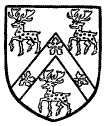
We discovered among the artifacts in a mysterious cardboard box handed down generation to generation, a ring. This ring had the coat of arms upon which three deer are represented. We found out the coat of arms apparently represents a branch of the Robinsons known as "Rokaby". This would indicate that John Robinson was a "Rokaby" Robinson and therefore, potentially, part of someone's substantial ancestral chart we could photocopy. There is certainly room for more research in this area.
Valentine Best
- was Speaker of the Pennsylvania Legislature and was
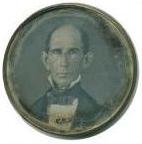 instrumental in founding Montour County, Pennsylvania. He founded the Danville
Intelligencer in 1828, as the organ of the Democratic party. He was described
as "a man of strong will, ardent passions and in his dealings scrupulously
honest. His paper was intensely Democratic and one of the most bitter and
instrumental in founding Montour County, Pennsylvania. He founded the Danville
Intelligencer in 1828, as the organ of the Democratic party. He was described
as "a man of strong will, ardent passions and in his dealings scrupulously
honest. His paper was intensely Democratic and one of the most bitter and
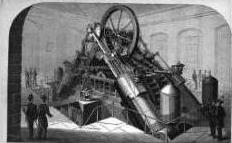 unrelenting against a political opponent. The Intelligencer from its first
issue in 1828, to the present time [1858], has been the local organ of the
Democratic party."
unrelenting against a political opponent. The Intelligencer from its first
issue in 1828, to the present time [1858], has been the local organ of the
Democratic party."
Valentine married Eleanor Woodside. Their daughter, Anna Marie Best, joined the Daughters of The American Revolution and married John Robinson, not necessarily in that order.
Alexander Graydon
- was part of the famed evacuation of Long Island by
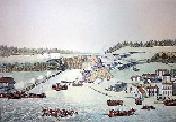 Washington. This evacuation and narrow escape by the American forces saved any
future the American cause had. However, he returned to Fort Washington and was
captured during the siege of that fort in November of 1776. He describes how
the Highlander soldier who captured him said in a heavy Scottish accent, "Young
man, ye must never disobey yer king." He was then saved by his mother, Rachel Marks:
Washington. This evacuation and narrow escape by the American forces saved any
future the American cause had. However, he returned to Fort Washington and was
captured during the siege of that fort in November of 1776. He describes how
the Highlander soldier who captured him said in a heavy Scottish accent, "Young
man, ye must never disobey yer king." He was then saved by his mother, Rachel Marks:
Rachel Marks
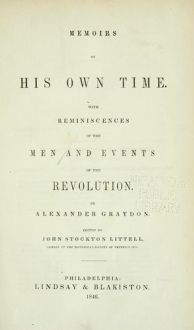
- apparently of German ancestry and one remarkable woman. She single handedly operated a boarding house in Philadelphia and mothered her children. While running the boarding house, she of course had many British guests, of whom several were British officers. She drew on her acquaintance with these officers to eventually free her son from captivity. She should go down in history as one of the heroines of the Revolution. She valiantly crossed British lines and marched right up of William Howe, the commander himself, and asked forcefully if she might have her son back. He agreed, and a parole was secured for Alexander Graydon. Her courage was recorded in Alex's book, "Memoirs of His Own Time," and we all should be proud we have such a feisty woman in our lineage.
John Woodside
- Graydon mentions John Woodside in his book "Memoirs of His Own Time." Woodside and Andrew Forrest were also prisoners of the British after the Fort Washington debacle. Woodside and Forrest were exchanged. Woodside later joined the militia in Philadelphia. He went on to become a pioneer, trekking into the wilderness where Danville now stands and was one of the founders of Danville, PA. While camped there, he was attacked by an Indian, (who was understandably upset by the land grabbing of the Americans) scalped, and left for dead. He survived, however, to marry Helen Montgomery. Their daughter Eleanor Montgomery Woodside married Valentine Best. His hair probably grew back!
Andrew Forrest
- fought in the revolution alongside John Woodside. Andrew Forrest became Danville's first doctor. He probably treated his buddy John Woodside after the scalping. (Maybe John could be considered Danville's first patient). Andrew married Jane Graydon, sister of the writer of "Memoirs of His Own Time." Eleanor Forrest married Thomas Best, Valentine's father. It is rumored that the rest of the Bests moved to Canada. That part of the saga is vague and needs someone compulsive enough to dig it up.
George Bryan
- was born in Ireland, 1731, and served as vice president, 1777,
 then president, 1778 of the Supreme Executive Council of Pennsylvania. The
Constitution of Pennsylvania was primarily written by George Bryan and Benjamin
Franklin. It revolutionized Pennsylvania by transforming it from a colony of
Britain to a commonwealth ruled by its own citizens. It became a boilerplate
then president, 1778 of the Supreme Executive Council of Pennsylvania. The
Constitution of Pennsylvania was primarily written by George Bryan and Benjamin
Franklin. It revolutionized Pennsylvania by transforming it from a colony of
Britain to a commonwealth ruled by its own citizens. It became a boilerplate
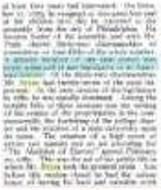 for the American Constitution. In 1780 Bryan introduced a measure that would
eventually abolish slavery in the Commonwealth. The act passed under his
persistent lobbying and became the first state law of its kind. He was
appointed judge of the Supreme Court of PA, 1780, and was on the bench until he
died in 1791 in Philadelphia.
for the American Constitution. In 1780 Bryan introduced a measure that would
eventually abolish slavery in the Commonwealth. The act passed under his
persistent lobbying and became the first state law of its kind. He was
appointed judge of the Supreme Court of PA, 1780, and was on the bench until he
died in 1791 in Philadelphia.
John Lea
- came over to Pennsylvania with William Penn on his second voyage. He also
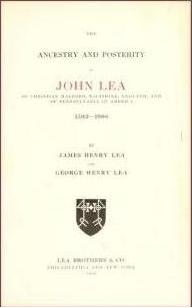 has a long ancestry in England which was painstakingly reconstructed in a book
called "The Ancestry and Posterity of John Lea" by James and George Lea. The Leas who
came to America lived in Christian Malford. Lea was born in 1661. A fire
in 1653 burned most of the parish records, but the Lea family used the heraldry evidence
has a long ancestry in England which was painstakingly reconstructed in a book
called "The Ancestry and Posterity of John Lea" by James and George Lea. The Leas who
came to America lived in Christian Malford. Lea was born in 1661. A fire
in 1653 burned most of the parish records, but the Lea family used the heraldry evidence
 to bring the family history back to the 12th century. The Lea coat of arms was the lion
rampant with sanglots (drops of blood). The church at Christian Malford was the
site of famous midsummer rituals (what were they about? I'm very curious) until the
mid-seventeenth century.
to bring the family history back to the 12th century. The Lea coat of arms was the lion
rampant with sanglots (drops of blood). The church at Christian Malford was the
site of famous midsummer rituals (what were they about? I'm very curious) until the
mid-seventeenth century.
Katherine Tilden
- Married John Marshall. This is the union that crosses the Pennsylvania Quakers with the Maryland Anglicans. Talk about religious confusion. The Maryland Anglicans all hail from Kent County, Maryland, Shrewsbury Parish. There is a book called "Old Kent" by George Hanson, which mentions many of these Maryland ancestors. They were all at one time or another vestrymen and wardens in the Shrewsbury Church. Kennedyville, where a lot of them lived, is nearby, as is Great Oaks Manor where Marmaduke Tilden moved when he came to the East shore early in the 17th century.
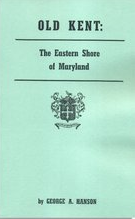
Marmaduke Tilden
- founded Great Oak Manor, Kent County MD. He died in September, 1670. His eldest son, Marmarduke Jr. owned at one time thirty-one thousand three hundred and fifty acres of land. Marmaduke Jr. married Rebecca Wilmer. Their daughter, Ann Tilden was known as "Wealthy Ann Tilden."
Sir William Tylden
- (The Americans changed the "y" to "i") of Great Tyldens, the grandfather of Marmaduke Tilden of Great Oak Manor, Kent County MD, was descended from Sir Richard Tylden who was living in the reign of Henry II and Richard I. He was seneschal to Hugh De Lacy, Constable of Chester during the reign of Henry II, and afterwards accompanied Coeur De Lion to the Holy Land and fought under him in the Battle of Ascalon against the Sultan Saladin, in the year 1190.
 The family of Tyldens, one of great antiquity, has been seated in Kent (England)
for several centuries. One of the branches of Tyldens moved to Sussex. And one
of its members, emigrating, founded the numerous Tildens of America. It is
through the Tylden (earlier: Tilghman) line, via Alice Berkeley and Joan De Beaufort,
that we are descendants of the Plantagenets (King Edward I, II, III; Henry I, III,
Philip IV...). References to the Tilden family are found in Sir Bernard Burke's Landed Gentry.
The family of Tyldens, one of great antiquity, has been seated in Kent (England)
for several centuries. One of the branches of Tyldens moved to Sussex. And one
of its members, emigrating, founded the numerous Tildens of America. It is
through the Tylden (earlier: Tilghman) line, via Alice Berkeley and Joan De Beaufort,
that we are descendants of the Plantagenets (King Edward I, II, III; Henry I, III,
Philip IV...). References to the Tilden family are found in Sir Bernard Burke's Landed Gentry.
Joan De Beaufort
- daughter of Prince John Plantagenet, son of Edward III, and Katherine Swinford,
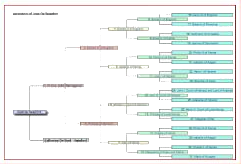 John's mistress. The affair became permanent, and legitimatized by the Pope and Edward II.
Of course, this led to a number of machinations, manipulations, etc. in the wrestling for
the throne by subsequent generations. Their story is documented by the famous British novel
John's mistress. The affair became permanent, and legitimatized by the Pope and Edward II.
Of course, this led to a number of machinations, manipulations, etc. in the wrestling for
the throne by subsequent generations. Their story is documented by the famous British novel
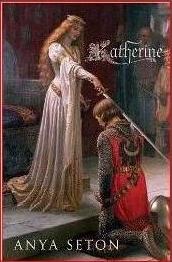 "Katherine" by Anya Seton. It is considered a landmark among historical novels.
"Katherine" by Anya Seton. It is considered a landmark among historical novels.
Katherine and her daughter Joan were buried side by side in a beautiful tomb, which was despoiled by the Roundheads in 1644.
Again quoting from my brother: "There is much more of course. It's fascinating because every once and while you find a piece on one of these people that illumines a whole period of history in a way that causes you to see that time in a new way." Here is a small sample from a letter by Thomas Paschal dated 1685:
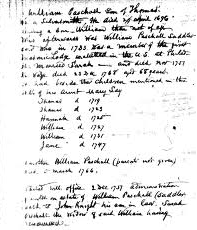
"William Penn and those of his Company have arrived in good health and he has been received with great satisfaction as also in NY where he went and was generously treated. There is a city here called Philadelphia where there is a market, and another at Chester that was formerly called Upland. William Penn is striving to bring about a union between the cities.
"I have recently been on the other side of the river De Laware at Burlington in West Jersey at the fair where there was a great concourse of people and great abundance of English merchandise we could get for a reasonable price, for this country is full of goods; tin and copper are very common. There is need here of Spanish cloth, of frizettes or ratteens and iron pots, but what is most in demand is linen and coarse stuffs. These Swedes and Finns are an industrious people. They employ in their building little or no iron. They will build you a house without any implement than an axe. With the same axe, they will cut down a tree and have it in pieces in less time than two other men would spend in sawing it. There are a great quantity of birds and one hardly thinks it worth while to shoot at ring pigeons and pheasants. One can get venison from the Indians cheap and formerly they gave it to the Swedes at a half less. I have had three deer for three ells of coarse stuff which cost me less than three florins. We have also had bears meat for nothing or for very little. Our gardens supply us all sorts of herbs, some of which are not in England. Here are roses, currants, gooseberries, turnips, white carrots, onions better than in England. Peaches of three kinds, and in such quantity that they let them fall on the ground where they rot and the swine eat them. Sincerely, Thomas Paschal, 1685."
Photo Gallery (hover to read, click to enlarge)





